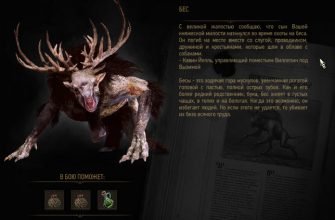In the expansive world of “The Witcher 3: Wild Hunt,” succubi stand out as a unique class of monsters, capable of balancing both the allure of seduction and the threat of danger. Geralt of Rivia, the player-controlled protagonist, encounters these creatures during specific quests. This article explores the dynamics of succubi encounters, their characteristics, and how players can either defeat them in combat or explore more benevolent resolutions. We will also discuss how players can ‘sleep’ with succubi, where applicable.
In The Witcher 3: Wild Hunt, succubi are not just creatures of mere malevolence but are part of a nuanced narrative that reflects their hybrid nature. These beings, primarily featured during the quests “Practicum in Advanced Alchemy” and “Deadly Delights,” offer players opportunities to engage in combat or engage with the narrative choices. For those eager to seek out these creatures, the experiences are as varied as they are intriguing.
Where to Find Succubi
Succubi in The Witcher 3 are mainly encountered during two primary quests:
- Practicum in Advanced Alchemy: Found in the Skellige Isles, this quest involves a mystical and botanical challenge that requires the help of diverse beings, including a succubus.
- Deadly Delights: Located in Novigrad, this quest begins at the Harborside Notice Board. It involves solving the mystery behind the deaths of soldiers, coincidentally involving a succubus named Salma.
Each quest offers a different narrative path, giving players the chance to make moral decisions that create significant storyline implications. Succubi are known for their enchanting beauty and intelligence, caught between the domains of humans and monsters, often driven by their desires rather than pure malice.
Understanding Succubi: Appearance and Traits
Succubi are part of the Hybrid class of monsters. Their mixed attributes put them in a fascinating intersection between the humanoid and mythical beasts. With their striking appearances, succubi possess alluring beauty, which they use as a passive attack against their victims.
| Succubus Type | Description |
|---|---|
| Hybrids | Succubi are classified under the Hybrids category, utilizing both their physical charm and their magical abilities to destabilize enemies. |
Despite their aesthetic charm, they are capable of extreme ferocity if threatened. This complex nature makes encounters with succubi a multifaceted affair, allowing players to both empathize with and be wary of these fascinating creatures.
Defeating Succubi: Strategies and Preparation
For players aiming to defeat succubi in combat, understanding their weaknesses is key:
- Weakness 1: Dimeritium Bomb – This bomb is essential for interrupting a succubus’s ability to cast spells, making them vulnerable to attacks.
- Weakness 2: Quen Sign – Providing Geralt defensive capacity, the Quen Sign is crucial to sustain less damage during combat.
Furthermore, a strong sword arm and the right equipment are significant in dealing with these creatures:
- Recommended Sword: Silver Sword
- Recommended Oil: Hybrid Oil – Coating your sword with Hybrid Oil can increase damage dealt to succubi.
Strategically, the use of the Aard Sign can disrupt a succubus’s spell casting, creating windows of opportunity for Geralt to deal damage. Additionally, the Northern Wind Bomb is highly effective in freezing them in place, taking full advantage of their vulnerabilities.
Engaging with Succubi: Narrative Choices
While the option to confront and kill a succubus is available, “The Witcher 3” often presents players with the more intricate choice of sparing them. This route allows players to delve deeper into the lore and motivations of the succubi.
Practicum in Advanced Alchemy
In this quest, jousting with the succubus involves a more benevolent approach. Her assistance with alchemy is beneficial, and players can choose to leave the succubus unharmed, aligning Geralt’s actions more closely with his role as a protector against malice rather than an indiscriminate killer.
Deadly Delights
In Novigrad’s “Deadly Delights,” players encounter Salma, a succubus whose seductions have led to fatal consequences for certain guards. Players are faced with a moral decision: kill Salma to quell the threat or discover a way to peacefully resolve the situation.
- Combat Options: Slaying Salma assures a trophy for completing the contract and eradicating the perceived threat.
- Communicative Resolution: Listening to her side of the story reveals a narrative of misunderstood intentions. Salma offers Gehralt a relic silver sword and a trophy, provided an agreement to leave the city is met.
These choices are not only indicative of Geralt’s nature but influence the way players perceive other sentient creatures within the game, promoting empathy over extermination.
Sleeping with Succubi: Exploring Intimacy
The notion of ‘sleeping’ with a succubus is less about physical encounters and more about navigating the unspoken allure succubi possess in their interactions with Geralt. While traditional romantic engagements occur more frequently with human characters, succubi have an underlying metaphor for the temptation of carelessness versus understanding beings driven by their instincts.
Geralt’s approach to succubi, whether through swordplay or conversation, reflects the broader themes of the game: choices, consequences, and the ambiguity of morals in a world filled with shades of gray. By choosing dialogue over massacre, players often find depth in the game narrative that might be missed through a strictly combative approach.
Conclusion: Succubi as Part of the Witcher Cosmos
The succubi portrayed in The Witcher 3: Wild Hunt serve as a testament to the rich world-building and complexity found in the land of the Witcher. These creatures challenge players to assess their decision-making processes, highlighting themes of judgment, justice, and understanding. Whether engaging them through combat or dialogue, each encounter holds both risk and reward, balancing combat mechanics with narrative depth.
Ultimately, succubi in The Witcher 3 blend the line between predator and misunderstood mythical being. Choices made during interactions with them will resonate throughout Geralt’s story, ensuring that these encounters remain among the most memorable features of the Witcher’s journey.









